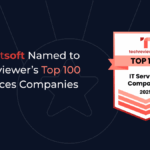“CRM is your GPS to a better route on your Business Development journey.” ― Bobby Darnell
Companies that use customer relationship management (CRM) systems have experienced a 47% increase in customer retention rate, a 21% improvement in productivity, 16% higher customer retention, and a 17% boost in lead conversions. So if you are a business owner looking to improve customer relationships and streamline internal processes, this article is for you. In this comprehensive guide, we will explore the various aspects of custom CRM implementation, from the process to its benefits.
While it takes 13 months to see an ROI from this tech investment, the $45 per dollar spent is well worth the wait.
Advantages of a Custom-Built CRM
Because every business is unique, custom solutions offer tailored features that can create the best experience for their specific customers. Unlike ready-made CRMs, which come with unnecessary features, choosing custom solutions allows you to build the exact functionalities your teams need, saving money in the process.
Big brands have already adopted custom-built CRMs in favor of pre-made ones.
For example, Apple and Uber use custom-built CRMs to drive sales and customer engagement.
Amazon’s own CRM captures customer data at the point of purchase, instantly customizing the user experience and providing a full view of the customer journey. This helps reduce returns and cart abandonment.
Similarly, Tesla started using its own CRM in 2019. Today, the company boasts the highest customer satisfaction rate in the car manufacturing industry according to Consumer Reports. Ninety-one percent of Tesla owners are more likely to rave about their vehicles than other brands, partly due to their in-house developed sales software.
Overcoming Challenges with Tech Partner
While custom-built CRMs can present challenges such as higher costs, longer development times, and maintenance complexities, these can be effectively managed with the right approach. To circumvent these challenges smoothly, partner with a software provider specializing in custom software, such as Intellectsoft.
What is a CRM Implementation?
Beyond just setting up software, CRM implementation is a strategic move towards better understanding and managing your interactions with current and future customers. It’s a holistic process that entails meticulously configuring the software to align with your unique business needs, ensuring that every customer interaction is captured, analyzed, and leveraged to foster stronger relationships. Your CRM implementation plan shall begin with a deep dive into your business-specific requirements and goals.
Choosing your CRM development partner is next, and it’s a decision that should not be taken lightly. This is where expertise meets execution. Partnering with a company that not only understands the intricacies of CRM systems but also appreciates the unique challenges and opportunities within your industry can make a significant difference.
Before hiring a developer, make sure they are capable of tailoring the CRM to fit your unique business requirements. A one-size-fits-all approach simply does not apply to CRM systems. Your development partner must also bring the training aspect to the table. Onboarding your team to effectively utilize the CRM system according to their respective roles is a pivotal part of the implementation.
And the final step, which is not an endpoint but a commitment to continuous evolution. Regular monitoring and evaluation of the CRM system’s performance against your objectives allow for timely adjustments and optimizations.
Let’s explore the details of the implementation steps in the next section.
CRM Implementation Process: 6 Steps to Success
CRM implementation is a multifaceted undertaking that necessitates a roadmap marked with critical milestones to ensure a smooth transition and alignment with your business goals. This roadmap is not just a path but a strategic blueprint for transforming customer relationship management within your organization.
Below are the six essential steps to navigate this journey successfully:
Step 1: Identify CRM Goals
Delineate what you aim to achieve, whether it’s enhancing customer engagement, improving customer interactions, optimizing sales processes, or refining marketing strategies. Having crystal-clear goals sets a targeted direction for the implementation process.
This stage is crucial as it establishes the foundation for the entire process. Setting objectives early on guides the entire procedure so that every decision aligns with your business aspirations.
Step 2: Consider Required CRM Integrations
Assessing your current operational workflows and technology stack is imperative before introducing a new CRM system. Evaluating the current ecosystem shows potential problems and chances to streamline. It confirms the new CRM system can blend into it.
This is where you pinpoint the applications your CRM needs to synchronize with, such as email platforms, social media channels, and customer service tools. The goal is to establish seamless data flow and functionality across all operational areas. After all, a CRM is supposed to enhance efficiency and provide a unified view of customer interactions.
When you have created a cohesive ecosystem where data flows freely, you will be able to provide your team with the insights they need to make informed decisions.
Step 3: Choose Your CRM Development Partner
The right partner not only brings technical prowess but also possesses a deep understanding and extensive experience in the following:
Data Management
A good CRM software vendor delivers cutting-edge techniques like advanced data management, predictive analytics, and smart automation. They must be knowledgeable in tapping into the latest technology trends, such as Big Data, AI, Machine Learning, and Blockchain, to stay at the forefront.
Software Integration
Choose a company that can enhance your technological foundations through the development of robust microservices, dependable API structures, and seamless data integration techniques. You can propel your strategic objectives forward if they are capable of creating comprehensive enterprise applications or leveraging enterprise app integration solutions to streamline your operations and foster innovation.
Legacy Application Modernization
Outdated software not only poses significant security risks but also demands high maintenance costs. Engage leading experts to conduct comprehensive reviews of your systems and upgrade them with cutting-edge tools and technologies for enhanced performance and security.
Step 4: Customize for Tailored Solutions
Customizing a CRM system involves adjusting features, functionalities, and interfaces to align with your workflows, user needs, and overall business strategy. It requires a detailed checklist that enables you to create a configured design that delivers on its promise to enhance your business operations and customer relationships.
Instituting a governance framework will also provide guidelines on how the CRM system should be used and maintained. This typically includes standards and procedures for data management, user access, customization, and system updates that guarantee your CRM initiative’s long-term sustainability.
Step 5: Empower Teams with Training
The success of a CRM implementation heavily relies on user adoption. It’s not just about knowing which buttons to click but also understanding how to leverage the system to enhance customer interactions and drive business growth.
Providing comprehensive training sessions ensures your team is well-equipped to unleash the full potential of the system. This empowerment not only enhances efficiency but also fosters a culture of continuous improvement.
Step 6: Ongoing Assessment and Adaptation
No enterprise is static, so your CRM system shouldn’t be either. Establish an iterative process that ensures it remains agile, responsive, and aligned with your evolving business needs. For example, conduct weekly performance reviews of your CRM system to track its efficiency. Also, consider utilizing CRM analytics tools should be utilized to gauge user adoption and the system’s effectiveness in achieving business goals.
Always be open to incorporating new functionalities as the CRM vendor releases updates or your business needs shift. Regular employee feedback can also be invaluable in spotting areas of the CRM system that need tweaking for better performance.
Navigate these steps with precision and strategic foresight, and you will pave the way for a CRM implementation that not only meets but exceeds your expectations and drives your business toward enhanced customer-centricity and operational excellence.
Remember, effective CRM implementation is not just about technology but also about strategically aligning such technology with your business goals and customer needs.
Importance of CRM Implementation
In essence, CRM implementation is an investment in a strategic framework that transcends mere technological adoption by representing a strategic pivot toward a more engaged and insightful business model. It empowers your business to:
- be more responsive, agile, and customer-focused
- deepen the understanding of customer needs, preferences, and behaviors
- anticipate customer desires and tailor interactions to individual expectations
- build enduring relationships that drive loyalty and growth
- commit to operational excellence
- enable teams across sales, marketing, and customer service to work more coherently and efficiently
A well-implemented CRM system provides a unified platform that fosters collaboration and enhances the ability to act on data-driven insights. Consequently, you will achieve improved internal workflows, better customer experience, and a competitive edge in the marketplace.
Benefits of CRM Software Implementation
While implementing a CRM system is considered an operational upgrade, it’s actually a strategic investment that yields a high return over time in terms of catalyzing business growth and customer rapport improvement.
These are the changes your organization can expect post-implementation:
Precision in Sales Forecasting
CRM systems offer a granular view of sales trends and customer behaviors. This predictive prowess enables your business to craft strategies that are both responsive and anticipatory. As a result, you are staying a step ahead of market dynamics.
Enhancement of Customer Service
With a comprehensive CRM, customer interactions are no longer siloed but part of a continuum. Hence, support teams are able to deliver personalized and contextually relevant assistance. Doing so not only boosts customer satisfaction but also nurtures loyalty and retention.
Efficiency in Communication
Yet another advantage is breaking down barriers between departments, which streamlines internal communication and collaboration. Such a unified approach ensures that all team members are on the same page, marching cohesively towards common business goals.
Automation of Repetitive Tasks
Liberating your team from the mundane and routine everyday tasks allows them to focus on initiatives that drive business growth. This shift optimizes resource allocation while boosting employee morale as they engage in more meaningful and impactful work.
Highly Targeted Marketing Campaigns
Marketing efforts based on robust data analysis resonate with the intended audience, thus maximizing impact and return on investment.
As you can see, CRM software implementation touches every aspect of your business, from sales and customer service to internal workflows and marketing. This indispensable investment simultaneously propels operational excellence and promotes a customer-centric organization.
Wrapping Up
This guide has walked you through the essential steps in the planning, execution, and deployment of a CRM implementation strategy, underscoring the importance and benefits of adopting a CRM system tailored to your business needs.
Adding this software to your current tech stack guarantees to enhance customer relationships and elevate operational efficiencies. However, the system’s success greatly depends on the willingness of your team to adopt it. Statistics show that while 65% of businesses use CRM within the first five years of operations, less than 40% achieve full adoption. That’s why you should commission a vendor that is capable of training users from various departments of your company who perform different roles.
Partnering with a seasoned expert like Intellectsoft ensures not only a smooth transition but also an optimized integration of CRM into your business landscape. Our expertise in enterprise software development covers the full life cycle of application design, integration, and management.
We are experienced in deploying this technology through the construction, healthcare, dental, insurance, FinTech, logistics and automotive, travel and hospitality, and retail and e-commerce industries. Discover how our custom CRM software implementation helped a dental clinic scale new heights in this case study. For a deeper dive into how Intellectsoft can future-proof your business operations, visit our services page.
The post A Comprehensive CRM Implementation Guide in 2024 appeared first on Intellectsoft Blog.
Source link











